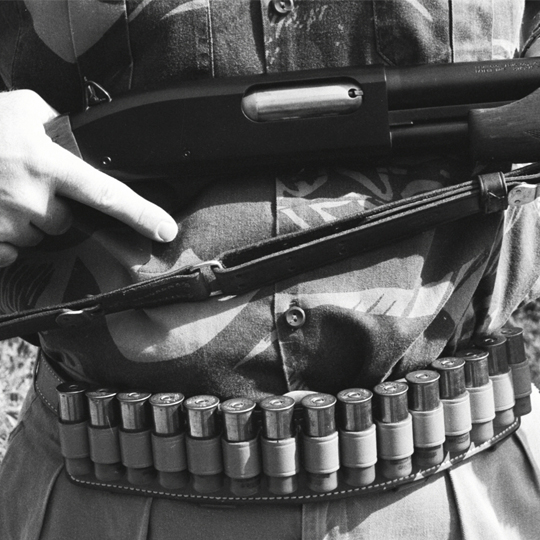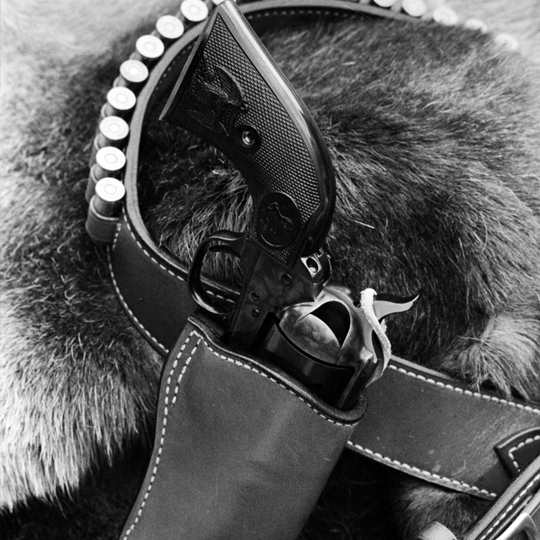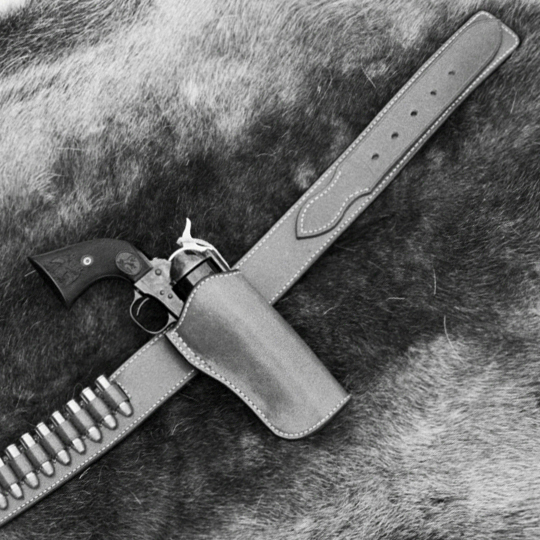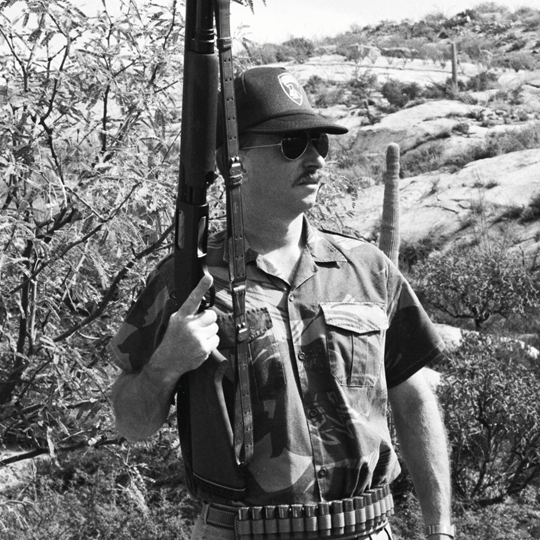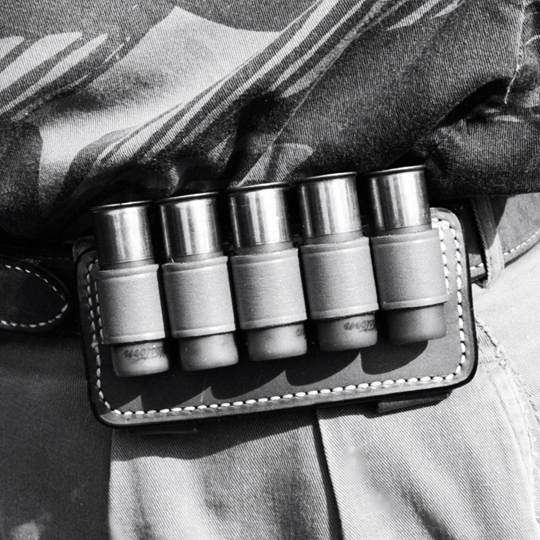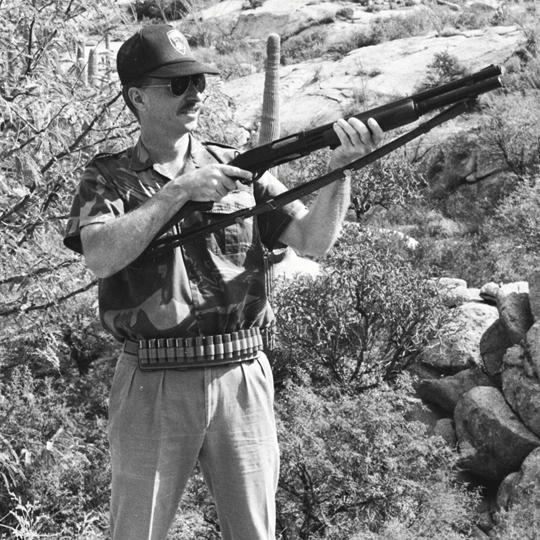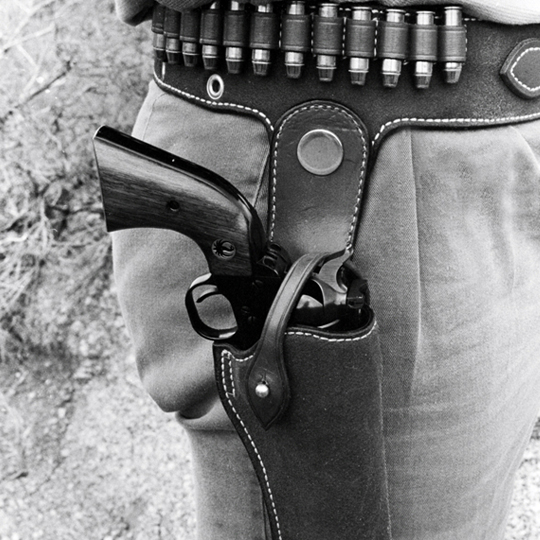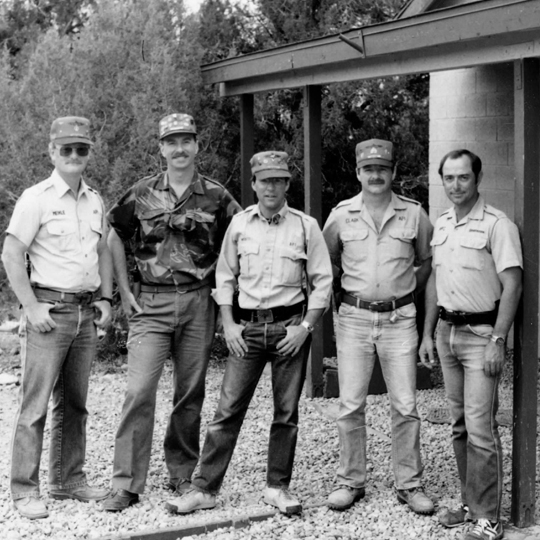
The Younger Years
Bruce Willner Nelson was born on Jan 3. 1948 in Duluth Mn. to
Clifford and Lois Nelson (both deceased). The family, including
younger sister Nadine, moved to California in the early fifties
during the big post war expansion. Nancy and Brian were born in
California. Bruce and Brian were 11 years apart. Dad got work in
the aerospace industry at Jet Propulsion Laboratory in Pasadena,
where he spent 35 years. Mom was a homemaker, until the kids
were all in school, then began to work in the public schools.
Bruce loved sports cars, music, photography and of course guns.
He was a Boy Scout, an excellent student and an accomplished
musician in the high school band, playing the trumpet.
By the time Bruce graduated high school, he had amassed a
nice collection of guns, a dozen or so. These were laid out on
shelves as some boys would have their toys. “When I was 12 years
old”, Bruce said, “I had a little neighborhood business,
watering lawns while people were on summer vacation. I would
start at the first house and turn on the sprinklers. Then I
would go to the next house, and the next. Then I’d go back
to the start of my route, and go from house to house and turn
the sprinklers off. There was a gun in the display case at
Reed’s Hardware Store. It was a Ruger .357 Magnum,
single-action revolver. After I got done watering lawns,
I’d ride my bike over there and make sure it was still
there and nobody else had bought it. The store owner would take
it out of the case and let me handle it. I’d count my
lawn-watering money, and figure out how much more I needed, and
how many more lawns I needed to water. Finally, I saved enough;
my dad came with me, and I bought that gun, I sure wish I still
had it. Anyway, I wanted to go to the public range, but I
didn’t want to put my new gun in my bike’s basket,
and I was worried about grown-ups telling me I couldn’t
carry my gun around. So, I asked the local chief of police what
I should do." “Son,” he said, “get yourself a holster and go
shooting. If anybody gives you any trouble, you tell them to
talk to me”. “The great thing was, nobody ever did give me any
trouble. There I was, 12 years old, riding my bike through the
streets of Glendora, California, packing a .357 Magnum, and
nobody looked twice. Can you imagine that happening today, with
everybody talking about the terrible ‘problem’ of ‘kids
and guns’?” Things were a lot looser back then.
It was Bruce’s Uncle Willard, a Deputy Sheriff, who
first took him shooting. As was usual in those days, Bruce
became an NRA member when he was seven years old. His father
paid the dues, and enrolled Bruce in a NRA Hunter Safety
class.
Bruce stitched his first leather goods together at home
when he was 16. When he could drive, he went to work for John
Bianchi who was located in Monrovia Ca. Both he and sister
Nadine worked for John. John was making holsters in his garage
and was just beginning to expand his business. It was John who
taught him the basics of gun leather.
Bruce grew up
in a family of shooters. This being the time when the Southwest
Pistol League was getting going. The family spent many weekends
going to matches around the southern California area. When Bruce
was in high school, he met some girls who said, “You like
shooting? Our dad does a lot of shooting. You should come by the
house, sometime.” And so, at age 16, he attended Jeff
Cooper’s first “Leatherslap” competitions in Big Bear,
California, and shot along side the likes of Ray Chapman,
Eldon Carl and Thell Reed.
Law Enforcement
When he graduated High school, he studied political science at
University of California at Riverside. Bruce worked for Bianchi
for a couple of years and liked it, but he really had his heart
set on being a cop himself. In, 1969, he became the fourth
member of the Fillmore (California) Police Department, where his
training was, as he recalled, pretty rudimentary. He sometimes
wondered if the citizens of Fillmore ever realized that they
were depending on a wide-eyed, wet-behind-the-ears, 21-year-old
to protect them from criminals while they slept.
After a year or two at the Fillmore PD, Bruce got a job
with the California Department of Justice, Bureau of Narcotics
Enforcement working in Los Angeles, San Diego and finally in San
Francisco. He investigated felony crimes of all kinds and spent
many years in narcotic investigations with the CDOJ serving as a
Detective and Undercover Agent. During this time, he supervised
a team of Narcotic Agents and served as Bureau Commander of the
Napa County, California, Special Investigation Bureau.
Bruce conducted firearms training for the Department of
Justice Special Agents, both in the Academy and in Officer
Survival Training. He organized and taught firearm instructor
schools for area officer firearms instructors and formulated an
Officer Survival Program that he presented to police and
sheriff’s departments throughout California as part of the
Department of Justice Advanced Training Center Program. Bruce
served as guest speaker and consultant for many other firearms
and police survival seminars and programs throughout the United
States.
While he was with the California DOJ, Bruce was one of the
early pioneers of the “Officer Survival” movement. In 1975, he
created the course outline for the CDOJ Advanced Training
Officer Survival Program, taught to 55 local law enforcement
agencies. Since the advent of officer survival training, police
officer injuries and deaths have declined dramatically. Bruce
was an evangelist for officer survival; he personally instructed
thousands of officers, and also taught instructors, to spread
the gospel of tactical training. It is not an exaggeration to
say that his efforts are continuing to be responsible for saving
many officers’ lives, over years.
San Francisco is where he met his future wife. Sandra
Froman, “Sandy”, was a young lawyer and law professor, who just
happened to be interested in defensive pistol craft simply
because she realized that defending herself was her own
responsibility. In fact, she had enrolled for Gun site training
even before she met Bruce. “I remember going to her house for
the first time,” he said. “She had Guns and Soldier of Fortune
and every other gun magazine you could think of. I
couldn’t believe my luck.” Sandy remembers their first
real date, after they had seen each other at a couple of group
functions. “He opened the car door for me. I got in. I knew he
was a cop; I knew he always carried his gun. He knew I was into
guns, too. He got in, pointed to the car’s glove
compartment, and said ‘Your gun is in there.’ ‘What do you
mean?’ I said. ‘Well, I’ve got my gun on, but in
case I need backup, yours is in there. ‘I thought, ‘Now,
that’s cool!’” They were married soon after.
IPSC and API/Gunsite
In the world of practical pistol competition, Bruce was a
pioneer, having been a Southwest Pistol League Class A shooter
and record holder starting in the mid 1960’s. He was part
of the now legendary Bear Valley Gunslinger matches conducted by
Jeff Cooper in Big Bear Lake, California. These matches served
as the “research laboratory” for development of the Modern
Technique of the Pistol. When Jeff Cooper launched the American
Pistol Institute(Gunsite) in 1976, Bruce was as API’s
first staff instructor.
Bruce was one of the 40 founding members of the
International Practical Shooting Confederation, formed in
Colombia, Missouri in 1976. He took second place in the I.P.S.C.
Columbia Conference Match, which served as the World Match for
that year. He was also the I.P.S.C. Southwest United States
Champion in 1977.
Combat Leather
During Bruce’s entire law enforcement career, he
always had space to work on his holster business on the
side, developing his craftsmanship and designs under the
name Combat Leather Limited and stamped each piece CLL. In
1985, Bruce retired from the CDOJ, and he and Sandy moved to
a house at the end of a long dirt road in the Catalina
Mountains, outside Tucson, Arizona. Sandy became a partner
in a big law firm and commuted to the city. He began
building full time under the new name Bruce Nelson Combat
Leather. There’s a period in the late seventies
through the eighties that is referred to as the resurgence
of American craftsmanship. This occurred in all fields, from
furniture to bicycles to holsters. Bruce’s interests
and passion concurred with this period and he had the
ability and talent to be a leader in that world. Bruce made
holsters, one at a time, by hand. There was no such thing as
a Bruce Nelson “second.” If it wasn’t perfect, he cut
it into pieces and threw it away. Demand always exceeded
supply.
All of Bruce’s law enforcement and practical
shooting background combined with the 25 years as an
exacting holster designer and leather craftsman contributed
to the success of his business, Bruce Nelson Combat Leather.
His influence on holster design has been considerable. His
#1 Professional and Summer Special designs have inspired
generation of imitations. Bruce’s philosophy was to
produce and offer to his clients only what improved upon the
designs already on the market. He worked hard to assure
meticulous quality in his very personal craft.
When he joined the California Department of Justice,
he became an undercover “narc” adopting a long-haired,
scruffy look that enabled him to bust many a doper. He tried
carrying his Colt .45 Commander concealed in a cheap,
clip-on, inside-the-belt-holster, and quickly discovered the
limitations of that design. So, he set out to improve
it, on his kitchen table, using the skills John Bianchi had
taught him.
First, he replaced the clip with a snap-on strap, so
that when he drew his gun, the holster didn’t come
with it. Then he reinforced the mouth of the holster with a
strip of metal sandwiched inside another strip of leather,
so that once a criminal was on the sidewalk and ready for
handcuffing, he could re-holster one-handed and eyes-off. He
used slightly heavier leather-still thin, but stiff rough
side of the leather out, to “grab” the clothing and help
keep the pistol properly positioned.
He sent a sample holster to Jeff Cooper, who responded
with a cryptic note:” Summer Special looks good.” The name
stuck. Bruce made a few Summer Specials for his fellow
undercover cops, but didn’t have enough time to
satisfy the demand. One of those cops made his way to the
remote Idaho shop of Milt Sparks and said, “Can you make a
holster like this?” Milt called Bruce and asked permission.
“No problem. Go ahead,” said Bruce.
Bruce’s other major contribution to holster
design was the rearbelt slot. Holsters had always been made
with a” tunnel” belt-loop, using either a folder-over flap
from the holster body itself or a sewn-on, separate piece.
Added to this, Bruce’s invention, the rear slot,
pulled the gun butt in tight to the body for better
concealment. Other holster makers picked up the idea.
Bruce’s “#1 Professional” holster inspired Milt
Sparks’ #55BN (guess what the “BN” stands for), the
Gordon Davis “Liberty,” the Bianchi “Askins Avenger,” and
many others.
Bruce’s gear has been sent all over the world,
England, Germany, Australia, New Zealand, South Africa,
Austria, Botswana, Norway, Sweden, Hong Kong –even a woman
in Argentina – Bruce’s client list goes on and on. “I
get orders with some unusual addresses – in care of U.S.
embassies in strange places,“ he said with a grin. Design
work for special operations units and elite military teams
is another Combat Leather specialty, with complete
confidentially promised.
“There are more gun owners in foreign countries than
in the United States,” he points out, “Even in England,
where there are a lot of sports shooters. There’s a
British holster builder who sells here in the U.S. In
Switzerland, every male over age 18 must own a rifle because
he’s in the Swiss army reserve. And the government
comes around every year and inspects the rifle and makes
sure that there’s ammunition for it in the house,”
Nelson notes. “Yet Switzerland has the lowest crime rate in
the world and almost non-existent homicide rate.”
Nelson’s years on the mean streets have given
him a special insight into the gear a plainclothes law
enforcement officer needs for survival. He’s been
there. He said there were seven or eight incidents in which
his ability to quickly draw his handgun may have saved his
life. One involved fugitives driving a stolen car and armed
with a double-barreled shotgun; the second, a fugitive who
reached for his AK-47 when Nelson burst into a Chula Vista
apartment to serve a warrant. In both incidents, the
fugitive decided against using their weapons when Nelson
beat them to the draw.
“Concealment is especially crucial in undercover
narcotics work”, Nelson says, “since experienced dealers
look for weapons”.
Bruce loved photography. He studied at workshops
with Ansel Adams. Ansel even printed one of Bruce’s
negatives. Bruce took all the pictures in his famous
catalog, did the layout, everything.
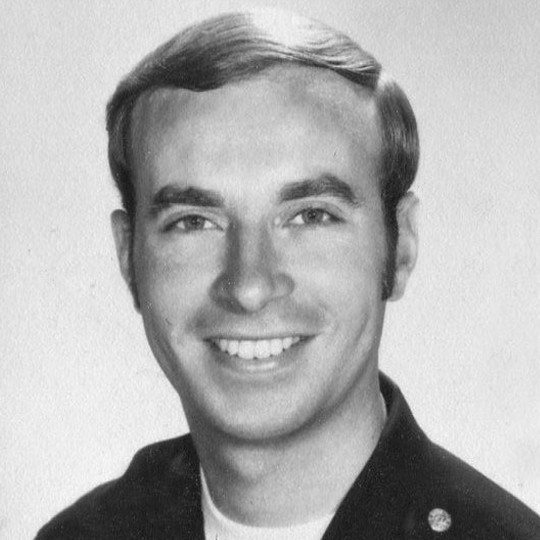
"A second can make all the difference, especially if you're
late!"
Bruce Nelson
Conclusion
Both Bruce and Sandy became active in the NRA, she as a
member of the Board of Directors, later as President, and he
as a member of the Law Enforcement Assistance Committee.
They were active in politics, too, volunteering to raise
funds, pass out flyers, stuff envelopes, make phone calls,
and write position papers on gun rights. More than one
politician came to realize that the “gun lobby” was not the
villainous gang portrayed by the talking heads on TV, but a
bunch of decent, intelligent,hard-working people like Bruce
and Sandy.
For a man trained in the art of combat and survival,
Bruce was infinitely gentle, loving and understanding. He
and Sandy would sit outside and watched the jackrabbits,
lizards, javelinas, coyotes and birds on whose land Bruce
and Sandy lived. They shot from the back porch at the Pepper
Poppers that decorated hills behind their home. Once in a
while, they would carry the Browning M2, .50 onto the porch,
and invite a few friends over for an evening of Class III
divertissement. They played with Dave, the French lop-eared
rabbit, who had the run of the house.
In November 1994, Bruce and Sandy were hiking in the
Grand Canyon, and Bruce felt tired and short of breath. They
figured it was the altitude and the extreme cold. The
breathing difficulty continued, off and on. A doctor
prescribed a succession of asthma-type inhalers, which
didn’t seem to help much. Bruce insisted on “working
through it,” and continue his exercise routine. He was
scheduled to take some pulmonary-function tests on the
afternoon of February 15th 1995. That morning, he collapsed
in his living room. He died in the ambulance, on the way to
the hospital. Cause of death was a pulmonary embolism, a
blood clot in his lungs. Bruce was not a religious man. No
clerics were present at his memorial ceremony. (However, it
probably set a record for the largest collection of .45s in
Summer Specials.)
Sandy said they often told each other that they loved
each other. She said, “A day never went by that we
didn’t talk about how perfect our lives were: we lived
in beautiful surroundings, we did work that we loved, and we
had each other. Bruce will be remembered as a man of
unwavering principles. He counted many friends but no
enemies. His life was full of great adventures and many
pleasures. A loving husband, son and brother, a superb
craftsman, a loyal friend, a true defender of American
rights and an outstanding gentleman in every way."
